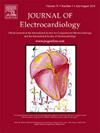新诊断杜氏肌营养不良症患儿的心电图特征
IF 1.2
4区 医学
Q3 CARDIAC & CARDIOVASCULAR SYSTEMS
引用次数: 0
摘要
背景:对于杜氏肌营养不良症(DMD)患者,心电图(ECGs)是一种重要的、常规的无创影像筛查工具。我们的研究旨在总结和探讨新诊断的DMD儿童的心电图特征。方法采用单中心回顾性研究,收集2018年7月至2023年12月在天津市儿童医院通过基因检测诊断的所有DMD患儿。记录12导联心电图,人工测量心电图参数。比较分析不同年龄和基因型亚组DMD与正常儿童心电图参数的差异。结果共纳入44例诊断为DMD的儿童,其中男性43例(97.7%)。平均诊断年龄36.78±21.69个月。DMD组与对照组心电图比较发现,DMD组导联Q波加深幅度v5 ~ v6 (p <;0.01),胸导联R波振幅增高(p <;0.01), V1导联R/S波幅比较高(p <;Sokolow-Lyon指数升高(p = 0.02)。结果显示,在7岁之后,心电图异常变得明显,反映了异常的严重程度和数量随着年龄的增长而增加。结论在资源有限的临床环境中,本研究中观察到的心电图异常对支持DMD的早期发现具有重要作用。本文章由计算机程序翻译,如有差异,请以英文原文为准。
Electrocardiographic characteristics of children with newly diagnosed Duchenne muscular dystrophy
Background
The electrocardiograms (ECGs) serve as a critical and routine screening tool of non-invasive imaging for Duchenne muscular dystrophy (DMD) patients. Our study aims to summarize and investigate the electrocardiographic characteristics of newly diagnosed DMD children.
Methods
We conducted a single-center retrospective study to collect all DMD children diagnosed through genetic testing at Tianjin Children's Hospital from July 2018 to December 2023. 12‑lead ECGs were recorded and ECG parameters were manually measured. The comparative analyses were conducted to assess the differences in ECG parameters between DMD and normal children across various age and genotype subgroups.
Results
A total of 44 children diagnosed with DMD were retrospectively enrolled, including 43 males (97.7 %). The average age at diagnosis was 36.78 ± 21.69 months old. Comparison of ECG between the DMD group and control group suggested that the abnormal ECG parameters such as deepened Q wave amplitude in leads V5-V6 (p < 0.01), increased R wave amplitude in chest leads (p < 0.01), a higher R/S wave amplitude ratio in lead V1 (p < 0.01), and an increased Sokolow-Lyon index (p = 0.02). The results revealed after the age of 7, additional ECG abnormalities became evident, reflecting a progression in the severity and number of abnormalities with increasing age.
Conclusions
The ECG abnormalities observed in this study could play a crucial role in supporting the early detection of DMD in resource-limited clinical settings.
求助全文
通过发布文献求助,成功后即可免费获取论文全文。
去求助
来源期刊

Journal of electrocardiology
医学-心血管系统
CiteScore
2.70
自引率
7.70%
发文量
152
审稿时长
38 days
期刊介绍:
The Journal of Electrocardiology is devoted exclusively to clinical and experimental studies of the electrical activities of the heart. It seeks to contribute significantly to the accuracy of diagnosis and prognosis and the effective treatment, prevention, or delay of heart disease. Editorial contents include electrocardiography, vectorcardiography, arrhythmias, membrane action potential, cardiac pacing, monitoring defibrillation, instrumentation, drug effects, and computer applications.
 求助内容:
求助内容: 应助结果提醒方式:
应助结果提醒方式:


